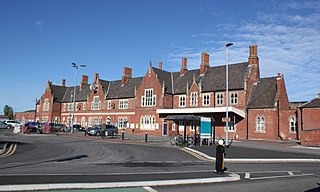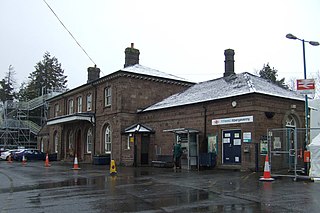Railways in Hereford | ||||||||||||||||||||||||||||||||||||||||||||||||||||||||||||||||||||||
|---|---|---|---|---|---|---|---|---|---|---|---|---|---|---|---|---|---|---|---|---|---|---|---|---|---|---|---|---|---|---|---|---|---|---|---|---|---|---|---|---|---|---|---|---|---|---|---|---|---|---|---|---|---|---|---|---|---|---|---|---|---|---|---|---|---|---|---|---|---|---|
| ||||||||||||||||||||||||||||||||||||||||||||||||||||||||||||||||||||||
Hereford has seen a history of expansion and decline in its railway history.
Railways in Hereford | ||||||||||||||||||||||||||||||||||||||||||||||||||||||||||||||||||||||
|---|---|---|---|---|---|---|---|---|---|---|---|---|---|---|---|---|---|---|---|---|---|---|---|---|---|---|---|---|---|---|---|---|---|---|---|---|---|---|---|---|---|---|---|---|---|---|---|---|---|---|---|---|---|---|---|---|---|---|---|---|---|---|---|---|---|---|---|---|---|---|
| ||||||||||||||||||||||||||||||||||||||||||||||||||||||||||||||||||||||
Hereford has seen a history of expansion and decline in its railway history.
Incorporated in 1826, this was a tramroad which linked with other earlier tramroads to form a continuous line between Hereford and Abergavenny. It was bought by the Newport, Abergavenny and Hereford Railway in 1846.
This railway was incorporated in 1859. It opened between Hereford and Moorhampton to goods traffic on 24 October 1862, to Eardisley for goods and passengers on 30 June 1863 and reached Hay-on-Wye on 11 July 1864.
Initially, the company used the short-lived Moorfields station, to the west of the city, but later used Barton and then Barrs Court station. The railway was taken over by the Midland Railway in 1874.
The line closed to passengers on 31 December 1962 and was shut completely in 1964.
This railway was incorporated in 1851 and the final section from Hopesbrook to Hereford section opened 1 June 1855. It was a broad gauge track, linking eventually to London Paddington through a 22-mile section from the Grange Court Junction in the Forest of Dean and on the South Wales Railway.
On 29 July 1862, the line was amalgamated with the GWR. In 1869, the line was converted from broad gauge to standard gauge in a five day period.
As part of the Beeching cuts, the Gloucester to Hereford line was closed on 2 November 1964.
Incorporated in 1854, the Leominster and Kington Railway connected Leominster with Kington and Presteigne.
Connecting to the Hay Railway via the Kington and Eardisley Railway at Titley Junction, a proposed plan to develop a cross-Wales line via New Radnor to Aberystwyth was never realised. Taken over by the West Midland Railway, it became a constituent part of the Great Western Railway.
It was at its busiest during World War II, when RAF Shobdon acted as a casualty distribution centre to local hospitals for both the British and later United States Army. It closed to passenger traffic in 1955, and shut pre-Beeching in 1963.
The Newport, Abergavenny and Hereford Railway (NA&HR) was incorporated in 1846, formed by the amalgamation of the Hereford Railway, the Llanfihangel Railway and the Grosmont Railway. A joint opening with the Shrewsbury and Hereford Railway took place on 6 December 1853.
The company was taken over by the West Midland Railway in 1860, which became part of the Great Western Railway in 1863.
The main Hereford station and headquarters of the Newport to Hereford line was Hereford Barton railway station to the west of the city. There was a short link which continued northwards to the Shrewsbury & Hereford line at Barrs Court junction, allowing for through North-South services. Later, in 1866, a connecting line was built branching East from the NA&HR to the south of the city from Red Hill, to Rotherwas on the Hereford Ross and Gloucester line which continued into Barrs Ct. Station. This enabled NA&HR trains to use Barrs Court station. Barton station was closed to passengers on 2 January 1893, with all services transferred to Barrs Coutt (the current Hereford station). Barton station was demolished in 1913, although facilities there remained open for freight until 1979. The through route from Red Hill to Barrs Court Junction, passing through Barton, remained open until around this time as a goods only line, avoiding the busy Barrs Court passenger station.[ citation needed ]
The Shrewsbury and Hereford Railway was incorporated in 1846. The Hereford section of the line officially opened at Barrs Court station on 6 December 1853, although the line had been used for goods traffic since the earlier in the year. It was leased jointly by the London & North Western Railway and GWR from 1862 and was transferred to joint ownership in 1868.
Incorporated in 1853. This railway was opened by the Worcester and Hereford Railway in stages from 1859 to 1861 with the final section Malvern Wells to Shelwick Junction (Hereford) opened on 17 September 1861. Midland Railway and the London and North Western Railway both collaborated in the line - the solicitor, Samuel Carter, was also solicitor to both of these major companies. [1]
The Worcester and Hereford Railway became part of the West Midland Railway on 1 July 1861 and the GWR on 1 August 1863.
Incorporated in 1860.
This was originally the Oxford Worcester & Wolverhampton Railway. It changed its name in 1860 and absorbed the Newport Abergavenny & Hereford plus the Worcester & Hereford. It also had agreements to work or leases on numerous branch lines in the English West Midlands region. The West Midland Railway's independent life was very short. It was leased to the GWR in 1861 and amalgamated with it in 1863.

The Welsh Marches line, known historically as the North and West Route, is the railway line running from Newport in south-east Wales to Shrewsbury in the West Midlands region of England by way of Abergavenny, Hereford and Craven Arms and thence to Crewe via Whitchurch. The line thus links the south of Wales to north-west England via the Welsh Marches region, bypassing Birmingham. Through services from south-west Wales, Swansea and Cardiff to Manchester and from Cardiff to Wrexham, Chester, the north coast of Wales and Anglesey constitute the bulk of passenger operations on the route.

Hereford railway station serves the city of Hereford, in Herefordshire, England. Managed by Transport for Wales, it lies on the Welsh Marches Line between Leominster and Abergavenny, is the western terminus of the Cotswold Line and also has an hourly West Midlands Trains service from Birmingham New Street. The station has four platforms for passenger trains and two additional relief lines for goods services.

Abergavenny railway station is situated south-east of the town centre of Abergavenny, Wales. It is part of the British railway system owned by Network Rail and is operated by Transport for Wales. It lies on the Welsh Marches Line between Newport and Hereford.
The Oxford, Worcester and Wolverhampton Railway (OW&WR) was a railway company in England. It built a line from Wolvercot Junction near Oxford to Worcester, Stourbridge, Dudley and Wolverhampton, as well as some branches.
The Pontypool, Caerleon & Newport Railway was promoted independently to relieve congestion on the heavily worked Eastern Valley Line of the Monmouthshire Railway and Canal Company. The Great Western Railway put up half the capital, making it in effect a GWR subsidiary. It opened in 1874, and most long-distance passenger and goods traffic, especially the heavy mineral traffic, transferred to it. It amalgamated with the GWR in 1876.
The Dulas Valley Mineral Railway was incorporated in 1862 to bring coal from the Onllwyn area north-east of Neath to the quays there, and in the following year was reconstituted as the Neath and Brecon Railway. The line was opened as far as Onllwyn in 1863.
The West Midland Railway was an early British railway company. It was formed on 1 July 1860 by a merger of several older railway companies and amalgamated with the Great Western Railway on 1 August 1863. It was the successor to the Oxford, Worcester and Wolverhampton Railway (OWWR).
The Merthyr, Tredegar and Abergavenny Railway, also known as the Heads of the Valleys line, was a railway line which operated between 1860 and 1958 between the Monmouthshire town of Abergavenny and the Glamorgan town of Merthyr Tydfil in South East Wales.
The Shrewsbury and Hereford Railway was an English railway company that built a standard gauge line between those places. It opened its main line in 1853.
The Newport, Abergavenny and Hereford Railway was a railway company formed to connect the places in its name. When it sought Parliamentary authorisation, it was denied the southern section, and obliged to use the Monmouthshire Railway between Pontypool and Newport.
The Monmouthshire Railway and Canal Company was a canal and railway company that operated a canal and a network of railways in the Western Valley and Eastern Valley of Newport, Monmouthshire. It started as the Monmouthshire Canal Navigation and opened canals from Newport to Pontypool and to Crumlin from 1796. Numerous tramroads connected nearby pits and ironworks with the canal.
Abergavenny Junction railway station was a station situated near the junction made between the London and North Western Railway's Heads of the Valleys line and the West Midland Railway's Newport, Abergavenny and Hereford Railway, which served the town of Abergavenny in the Welsh county of Monmouthshire.
The Hereford, Hay and Brecon Railway (HH&BR) was a railway company that built a line between Hereford in England and a junction with the Mid-Wales Railway at Three Cocks Junction. It opened its line in stages from 1862 to 1864. It never had enough money to operate properly, but the Midland Railway saw it as a means of reaching Swansea, and from 1869 the Midland Railway was given exclusive running powers over the HH&BR. There was then a long-running dispute over whether the Midland inherited rights of access previously granted to the HH&BR.
The Llancaiach Branch railway line was a mineral branch line in Glamorganshire, South Wales. It was authorised in 1836 as part of the Taff Vale Railway, and its purpose was to connect collieries at Llancaiach and bring their output to Cardiff for onward shipment. It was designed by Isambard Kingdom Brunel and built on the standard gauge. It opened in 1841 from a junction with the Merthyr line immediately south of Abercynon. It was intended to be horse worked, and included a self-acting rope-worked inclined plane near the junction. The collieries were slow to use the line, preferring their customary use of a tramroad and the Glamorganshire Canal, and the value of the line was diminished when the Taff Vale Extension line, an east-west connecting line belonging to the Newport, Abergavenny and Hereford Railway, intersected it and cut off the colliery connections, and the line became dormant.

The Coleford, Monmouth, Usk & Pontypool Railway (CMU&PR) was a standard gauge railway of 16 miles (26 km) which ran from Monmouth to Little Mill, near Pontypool in Monmouthshire, Wales. It was intended to convey the mineral products of the Forest of Dean to the ironworks of South Wales, by connecting to the Newport, Abergavenny and Hereford Railway at Little Mill Junction. The NAHR made the onward connection over its Taff Vale Extension line. The CMU&PR intended to acquire the Monmouth Railway, actually a horse-operated plateway, and convert it to locomotive operation.
The Worcester and Hereford Railway started the construction of a standard gauge railway between the two cities in 1858. It had needed the financial assistance of larger concerns, chiefly the Oxford, Worcester and Wolverhampton Railway, and the Newport, Abergavenny and Hereford Railway. It opened its line progressively from 1859 to 1861, delayed by exceptionally difficult tunnelling at Colwall and Ledbury. The company was purchased by the West Midland Railway in 1860, and that company amalgamated with the Great Western Railway in 1863.
Leominster and Kington Railway was one of four branches which served the Welsh Marches border town of Kington, Herefordshire.
The Crewe and Shrewsbury Railway was a railway company which was previously owned by the London and North Western Railway (LNWR), built to connect Crewe with the Shrewsbury and Hereford Railway which was jointly owned with GWR.
A Regional History of the Railways of Great Britain, Volume 13 - Thames and Severn. Rex Christiansen. 1981. ISBN 0-7153-8004-4